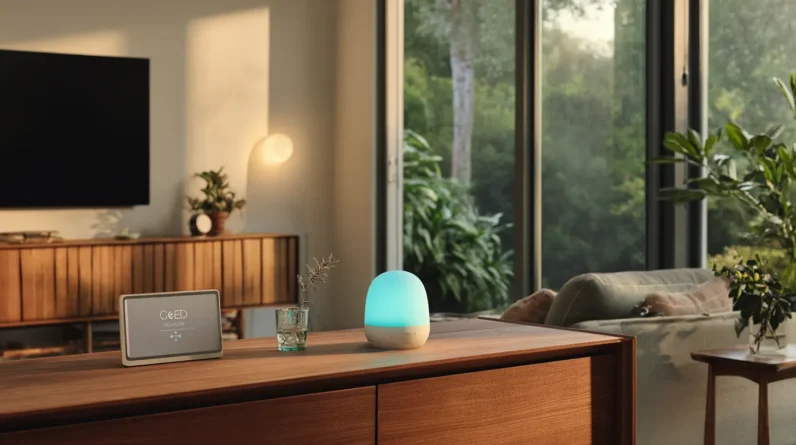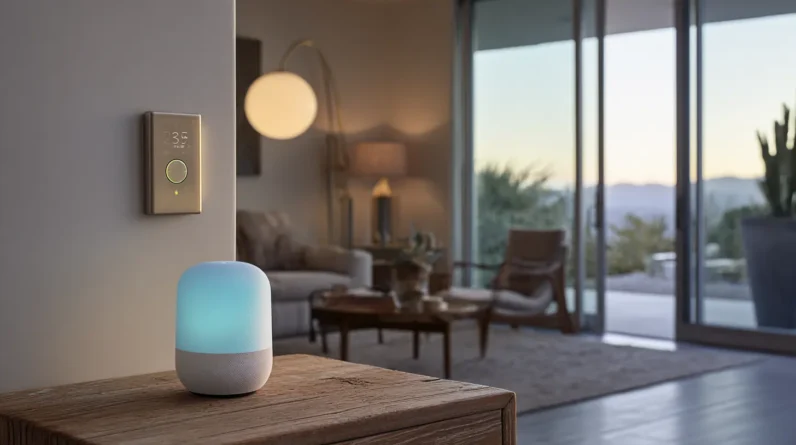
We expect our smart home devices to offer seamless voice control, integrating with assistants like Alexa and Google Assistant for effortless command. AI and machine learning should drive advanced functions, such as predictive modeling and enhanced security surveillance. Device security must be robust, with data encryption and secure authentication methods. Energy efficiency is non-negotiable, with real-time consumption data and integration with green tech. Proactive maintenance and automation should be standard, with continuous monitoring and predictive analytics. To truly elevate our smart home experience, we need to understand the nuances of these features and their implementation.
Seamless Voice Control Integration
In today’s interconnected world, integrating seamless voice control has become a pivotal feature for smart home devices. We expect our devices to respond instantly to vocal commands, making voice assistants like Amazon Alexa, Google Assistant, and Apple’s Siri indispensable. True seamlessness means we can control multiple devices simultaneously. Imagine this scenario: we’re hosting a gathering, and we want to play music throughout the house. With multi-room audio and voice control, we simply say, “Play jazz everywhere,” and the system intelligently syncs each speaker. This level of integration requires that our devices are always listening, always ready, and always capable of discerning our intent, no matter the background noise or individual accents. This isn’t just about convenience; it’s about creating a smart home that feels like a natural extension of ourselves.
Artificial Intelligence and Machine Learning
As we explore deeper into the capabilities of smart home devices, it’s clear that artificial intelligence (AI) and machine learning (ML) are the driving forces behind their advanced functionalities. These technologies enable devices to perform complex data analysis, identifying patterns and making decisions with minimal human intervention. Through predictive modeling, our smart home devices can anticipate our needs and adjust settings accordingly. For instance, a smart thermostat can learn our daily routines, using ML algorithms to modify temperatures and optimize energy usage. Similarly, AI-powered security systems can enhance surveillance by recognizing familiar faces and detecting unusual activities. By integrating AI and ML, we’re not just automating tasks; we’re creating systems that learn, adapt, and evolve to better serve our needs.
Advanced Security and Privacy Features
While AI and ML enhance smart home functionality, they also introduce concerns about security and privacy. To mitigate these issues, we should expect advanced security features in our smart home devices. Data encryption, for instance, must be standard. This guarantees that even if data is intercepted, it remains unreadable without the decryption key. Additionally, secure authentication methods like two-factor authentication (2FA) or biometric verification should be integrated. These measures prevent unauthorized access, adding an extra layer of security. Moreover, devices should offer regular software updates to patch vulnerabilities and protect against emerging threats. By prioritizing these features, we can enjoy the conveniences of smart homes without compromising our security and privacy.
Energy Efficiency and Sustainability
Although we’ve seen the impressive conveniences brought by smart home devices, it’s crucial we consider their impact on our energy consumption and environmental footprint. Integrating energy efficiency and sustainability into these devices is non-negotiable. We should expect smart home devices to be equipped with advanced power management systems, reducing their energy consumption and reliance on non-renewable sources. Furthermore, these devices should seamlessly integrate with green technology, such as solar or wind power, further promoting sustainability. Imagine charging our smart devices with renewable sources, or having them intelligently adjust power usage based on our daily routines. That’s the benchmark we must set. Additionally, devices should provide users with real-time energy consumption data, enabling us to make informed decisions and adjust settings to maximize efficiency.
Interoperability and Compatibility
Given the diverse range of smart home devices available, we must prioritize interoperability and compatibility to guarantee a seamless user experience. This means ensuring our devices adhere to common device standards and system protocols. We need to look for devices that support standards like Zigbee, Z-Wave, or Wi-Fi for wireless communication. Additionally, compatibility with major ecosystems such as Amazon Alexa, Google Home, or Apple HomeKit is vital. By doing so, we enable our devices to communicate effectively, work together harmoniously, and be controlled through a single interface. This level of integration allows for complex automation scenarios, enhancing the overall functionality and convenience of our smart home network.
Proactive Maintenance and Automation
Having established the importance of interoperability and compatibility, we now turn our focus to proactive maintenance and automation. This is where smart home devices truly distinguish themselves from their traditional counterparts. Through continuous device monitoring, our smart home ecosystems can gather data on performance and usage patterns. Employing predictive analytics, these systems can foresee potential failures or maintenance needs before they become critical. For instance, a smart HVAC system can alert us to replace air filters before efficiency drops, or a smart refrigerator can notify us of a potential compressor failure. Automation takes this a step further by autonomously adjusting settings based on our habits and environmental conditions. This proactive approach not only enhances convenience but also extends the lifespan of our devices and optimizes their performance.
Personalized User Experiences
Smart home devices aren’t just about automation and maintenance; they’re also about tailoring our living spaces to our unique preferences and routines. Personalized user experiences are a game-changer, thanks to advanced user profiling and behavioral analysis. These features allow our smart home systems to learn and adapt to our daily habits. For instance, the system can recognize that we wake up at 7 AM and automatically adjust the room temperature, brew our coffee, and turn on our favorite morning news channel. By continuously analyzing our behavior, the system refines its responses, creating an environment that’s not just smart, but intuitively personal. This level of customization guarantees that our smart home devices aren’t just tools, but integral parts of our lifestyle, enhancing comfort and efficiency.
Conclusion
We’re standing at the frontier of smart home technology, where voice control is seamless, AI learns our habits, and security is paramount. Remember, “A chain is only as strong as its weakest link”—so, insist on devices that prioritize interoperability, energy efficiency, and proactive maintenance. This isn’t just about gadgets; it’s about crafting a cohesive, personalized ecosystem. Let’s demand more from our smart homes.







